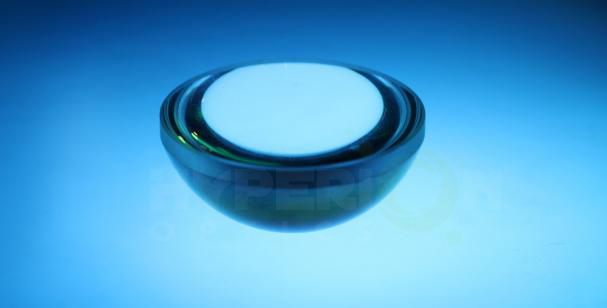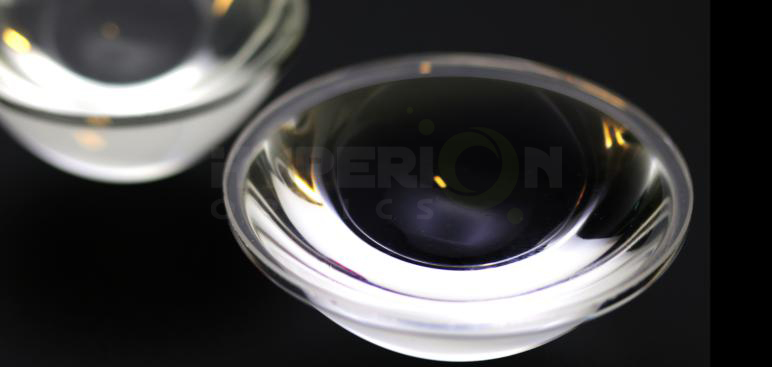The benefits of aspheric lenses
Spherical aberration correction
The most significant benefit of a non-spherical lens is that it can be corrected for spherical aberrations. Spherical aberration is caused by using the surface of the sphere to focus or focus on the light. Therefore, in other words, all of the spherical surface, no matter whether there is any measurement error and manufacture error, will appear spherical aberration, as a result, they will need a not spherical or aspherical Lenses surfaces, carries on the correction. By adjusting the constant of the cone and non-spherical coefficients, any non-spherical lens can be optimized to minimize the image difference. For example, see figure 1, which shows a spherical lens with a significant spherical aberration, and a non-spherical lens with almost no spherical difference. The spherical difference in the spherical lens will allow the incoming light to focus at many different points, creating a blurred image. In a non-spherical lens, all the different light rays will focus on the same spot, resulting in less blurred and more quality images.
In order to better understand the aspheric lens and spherical lens in terms of focus performance difference, please refer to a quantitative model, in which we can observe two 25 mm diameter equal to the focal length of 25 mm lens (f / 1 lens). The following table compares on the shaft (0 °Angle) and outside the shaft(0.5 °and 1.0 °Angle) in parallel, monochromatic light (wavelength 587.6 nm) generate the light spot size or fuzzy.Spherical lenses are several orders of magnitude larger than non-spherical lenses.
The benefits of additional performance
Although the market also has many different techniques for correction by spherical aberration resulting from the surface, however, these other technology in the imaging performance and flexibility, are far less than aspheric lens offer. Another widely used technique involves increasing f / # by "reducing" lenses. While this improves the quality of the image, it also reduces the flux in the system, so there is a trade-off between the two.
On the other hand, when using aspheric lens, the additional aberration correction support users in the realization of high flux (low f / #, high numerical aperture) of the system design at the same time, still keep a good image quality. Higher luminous flux design causing image degradation can be sustainable, because a slightly reduced image quality performance will still be provided above the performance of the spherical system can provide. Consider a focal length of 81.5 mm, f / 2 triad lens (figure 2), the first is composed of three spherical surface, the second is one of the first surface of spherical surface (the rest) for spherical surface, the two design have exactly the same type of glass, effective focal length, field, f / #, as well as the overall length of the system. The following table is quantitatively compared with the axis of the modulation transfer function (MTF) at the @ 20% contrast and the parallel, multicolored 486.1 nanometers, 587.6 nm, and 656.3 nm rays. A triad of aspheric surface lens has been used, all on the viewing angle showed higher imaging performance, its high tangential and sagittal high resolution, compared with only the triad of spherical surface lens is three times higher.
Glass Precision Aspherical Lenses, IR Aspherical Lenses, Off-Axis Parabolic Mirrors

Due to the more complex surface profile of asphere which significantly reduces or eliminate optical aberrations as compared to the simple lens, Aspheric lenses have at least one surface that is not a true sphere,It has been more widely exploited in the lens optical design stage.
At Hyperion Optics, we are equipped with Optotech asphere machine which offers our customers with contour deterministic micro grinding (CDMG) service, uses the accuracy and repeatability of a computer numerically controlled machine to grind the optical shape. We start by grinding the best-fit sphere to remove the bulk material and contour the aspheric shape into the optical material from edge to center. Typical materials available of our fabrication capability are optical glass, ZnSe, ZnS, BaF2, GaAs, and chalcogenide glass. We also accept materials supplied by customers.
Optical Machining Centers capability:
- Capacities from 5mm to 400mm
- 1000 to 24,000 rpm tool spindle
- Automatic curve correction
- Tool& Workpiece probing system
- Dual tool spindles option
Following such manufacturing procedure, there is no extra investment on tooling and processing fixtures for sphere substrates and preparation, contributes customers a quick and productive start to the schedule. With the asphere part ground, the profilemeter measure will be conducted and transfer measured data to the polisher. In our polishing process, our experienced operators can control the asphere form error within 1 micron (Depends on the diameter of the parts).
Hyperion Optics values every single opportunity offered by customers; our typical MOQ is two pieces for optical performance approval purpose at customers’ end; Our fast asphere prototyping has become one of our most popular services for customer low ratio initial production LRIP projects. We can process both sphere and asphere parts at the same time for customer’s objective or eyepiece design, which secures a reliable timeline management to meet LRIP tight timing requirement. Meanwhile, we also provide coating package with competitive pricing serving this rapid prototyping concept.
Our rapid aspheric prototyping / LRIP service including:
1.When Off-the-shelf aspheric parts do not fit perfectly in your system, Hyperion Optics can design and manufacture the Precision aspheric lenses by your system-level optical requirement.
2.Built to print, Hyperion Optics fabricates aspheric lenses and provides inspection report by your print.
3.Reverse engineering based on samples you provide, Hyperion Optics runs in-depth mapping and optical performance testing on either aspheric lens part or lens system level products, redesign and optimize including manufacturing and assembly.
Please contact one of our a sphere experts today and find out what Hyperion Optics can help you with your projects.
Still finding aspheric lens manufacturers? Leave us a message now.

Manufacturing Limits for Aspheric Surfaces
Based on Form Error Tolerance
| ||
Form Error > 2μm Lower Resolution Profilometry (2-D)1
| ||
Attribute
|
Minimum
|
Maximum
|
Diameter (mm)
|
3
|
250
|
Local Radius (mm)
|
-8 (Concave)
|
∞
|
Sag (mm)
|
0
|
502
|
Departure (mm)
|
0.01
|
20
|
Included Angle (°)
|
0
|
120
|
Form Error 0.5 – 2μm Higher Resolution Profilometry (2-D)1
| ||
Attribute
|
Minimum
|
Maximum
|
Diameter (mm)3
|
3
|
250
|
Local Radius (mm)
|
-12 (Concave)
|
∞
|
Sag (mm)
|
0
|
252
|
Departure (mm)
|
0.01
|
20
|
Included Angle (°)
|
0
|
150
|
Form Error < 0.5μm Interferometry with Stitching (3-D)
| ||
Attribute
|
Minimum
|
Maximum
|
Diameter (mm)3
|
3
|
250
|
Local Radius (mm)
|
-13 (Concave)
|
∞
|
Sag (mm)
|
0
|
252,4
|
Departure (mm)
|
0.002
|
1
|
Included Angle (°)
|
0
|
120+5
|
Labels: aspheric lenses, china lens, Glass Precision Aspherical Lenses, Hyperion Optics, IR Aspherical Lenses, lens, lens components, lens manufacturer, Lenses, Off-Axis Parabolic Mirrors

0 Comments:
Post a Comment
Subscribe to Post Comments [Atom]
<< Home